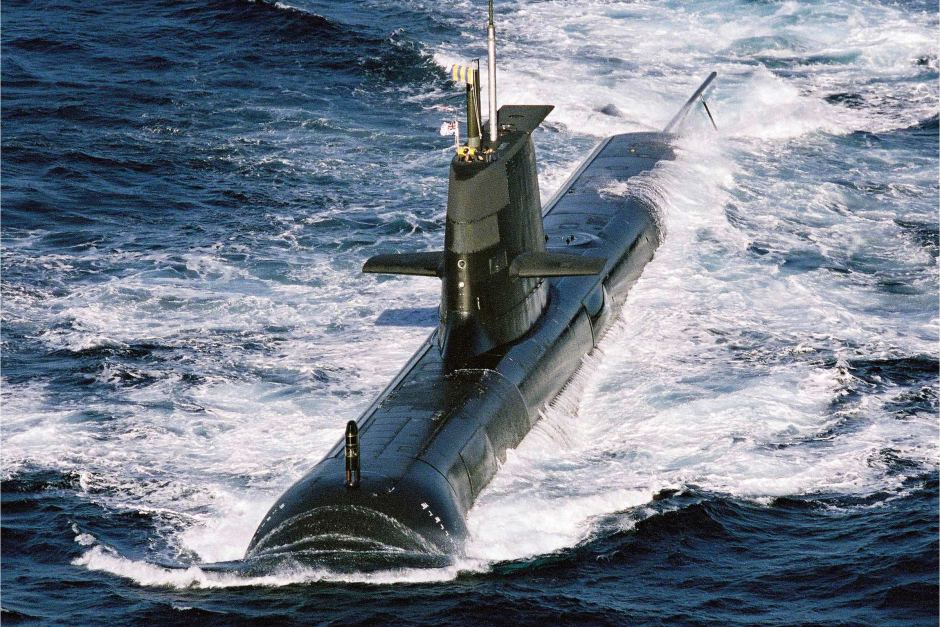Category: Defence Industry / Defence Forces / Air Force / Navy / Army / Defence and National Security / Defence and Aerospace Industries / Industry / Federal Parliament / Federal Government / Government and Politics
Australia joins Asian arms race with surge in ADF spending
Thursday, 25 Feb 2016 08:00:29

Australia's Navy will get 12 new submarines as spending increases. (ABPH Joanne Edwards)
Australia will embark on a decade-long surge in weaponry and military forces to defend its land, sea, skies and space from Asia's rapidly growing military forces.
Key points:
- Australia ratchets up military spending in response to rising tensions in Asia
- Spending up by nearly $30 billion in the next five years
- Climate change and terrorism also listed as threats
- Defence spending will rise even if GDP falls
The 2016 Defence White Paper maps a course towards a total of $195 billion in defence capability or equipment by 2020-21, together with a larger military force of 62,400 personnel.
Joining an Asian-region mini arms race, the White Paper promises 12 submarines to be built at a cost of more than $50 billion between 2018-2057.
However, maintenance costs will push that $50 billion budget much higher.
Navy will scoop a quarter of all new spending on capability, with nine new anti-submarine warfare frigates and 12 offshore patrol vessels.
The RAAF will build up two fleets of drones while also bringing its eventual fleet of 75 Joint Strike Fighters online.
The Army will claim 18 per cent of all extra spending on equipment, buying armed drones, new protected vehicles to transport troops, helicopters for special forces and a long-range rocket system.
Underscoring a sense of urgency to the renewal of Australia's defence power, the Government is aiming to build spending up to 2 per cent of GDP by 2020/21 — earlier than previously promised — representing an overall increase of $29.9 billion.
Prime Minister Malcolm Turnbull said the Government was committed to the "significant increase in spending" due to the challenges facing Australia from climate change and terror threats, among other issues.
 Photo:
The Army will claim 18 per cent of all extra equipment spending, purchasing armed drones among other weaponry. (AFP/US Air Force)
Photo:
The Army will claim 18 per cent of all extra equipment spending, purchasing armed drones among other weaponry. (AFP/US Air Force)
The factoring in of climate change was not planned under the Abbott Government.
The language of the White Paper points to a realisation that Australia needs to increase the "potency and agility" of its forces in the face of rising wealth and power in Asia, coupled with the strategic tension already arising between China and the United States.
"Territorial disputes … have created uncertainty and tension in our region," the White Paper notes.
"Some matters that previous defence white papers have described as long-term issues, such as the impact of modernisation in our region, now fall to this White Paper to respond to."
Australia continues to throw its military lot in with the United States, assessed to "remain the pre-eminent global power over the next two decades".
The White Paper aims to deepen Australia's alliance with America, including the relocation of a US spy telescope known as an "optical space surveillance telescope" to Exmouth in Western Australia.
On the path to building defence funding up to 2 per cent of GDP, the Government will also "de-couple" its spending on the military from the general health of the economy, so that even if growth slows, defence will still get its 2 per cent share.
 Photo:
Navy will scoop a quarter of all new spending on capability, with nine new anti-submarine warfare frigates and 12 offshore patrol vessels. (navy.gov.au)
Photo:
Navy will scoop a quarter of all new spending on capability, with nine new anti-submarine warfare frigates and 12 offshore patrol vessels. (navy.gov.au)
- About Us
- |
- Terms of Use
- |
-
 RSS
RSS - |
- Privacy Policy
- |
- Contact Us
- |
- Shanghai Call Center: 962288
- |
- Tip-off hotline: 52920043
- 沪ICP证:沪ICP备05050403号-1
- |
- 互联网新闻信息服务许可证:31120180004
- |
- 网络视听许可证:0909346
- |
- 广播电视节目制作许可证:沪字第354号
- |
- 增值电信业务经营许可证:沪B2-20120012
Copyright © 1999- Shanghai Daily. All rights reserved.Preferably viewed with Internet Explorer 8 or newer browsers.




 Send to Kindle
Send to Kindle
